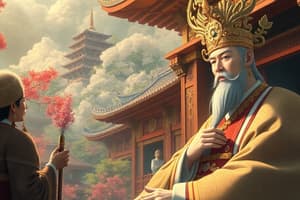Podcast
Questions and Answers
What was one of the reasons women found it easier to go on pilgrimages during this period?
What was one of the reasons women found it easier to go on pilgrimages during this period?
- Men were prohibited from going on pilgrimages.
- Women were no longer required to obtain official documents.
- The oshi of Yoshida stopped paying attention to female believers.
- The bakufu and daimyo loosened restrictions on travel. (correct)
Where did many women go on pilgrimage to in the first half of the eighteenth century?
Where did many women go on pilgrimage to in the first half of the eighteenth century?
- Hot springs in western Japan.
- Famous temples in central Japan.
- Mt. Fuji. (correct)
- Sacred mountains in eastern Japan.
What did the oshi of Yoshida request in 1740?
What did the oshi of Yoshida request in 1740?
- To prohibit women from going on pilgrimages.
- To increase the requirements for female pilgrims' travel documents.
- To decrease the number of female pilgrims.
- To loosen the requirements for female pilgrims' travel documents. (correct)
Why did women devise ways to bypass barriers?
Why did women devise ways to bypass barriers?
What did the oshi of Yoshida begin to do for female believers?
What did the oshi of Yoshida begin to do for female believers?
What was the result of the changes in restrictions on travel?
What was the result of the changes in restrictions on travel?
What was a significant factor in the popularity of the northern route for Mt. Fuji pilgrims?
What was a significant factor in the popularity of the northern route for Mt. Fuji pilgrims?
Why did some groups wish to descend the mountain along a different route from the one they used for the ascent?
Why did some groups wish to descend the mountain along a different route from the one they used for the ascent?
What was the outcome for climbing routes that were open only to men?
What was the outcome for climbing routes that were open only to men?
What change in policy did the religionists of Murayama, ?miya, and Subashiri make by the sixth month of 1860?
What change in policy did the religionists of Murayama, ?miya, and Subashiri make by the sixth month of 1860?
What was the initial restriction on female pilgrims on certain climbing routes?
What was the initial restriction on female pilgrims on certain climbing routes?
What can be inferred about the role of women in Mt. Fuji pilgrimages before the policy change?
What can be inferred about the role of women in Mt. Fuji pilgrimages before the policy change?
What was a major obstacle for female pilgrims during the Tokugawa period?
What was a major obstacle for female pilgrims during the Tokugawa period?
What document did female travelers need to obtain from their lord to pass through the barriers?
What document did female travelers need to obtain from their lord to pass through the barriers?
Why did the bakufu restrict the movement of women during the Tokugawa period?
Why did the bakufu restrict the movement of women during the Tokugawa period?
Which of the following highways was notorious for being especially strict with women?
Which of the following highways was notorious for being especially strict with women?
Where did female pilgrims traveling to Mt. Fuji from Edo and the eastern provinces have to go through?
Where did female pilgrims traveling to Mt. Fuji from Edo and the eastern provinces have to go through?
What changed substantially during the mid- and late Tokugawa period?
What changed substantially during the mid- and late Tokugawa period?
Flashcards are hidden until you start studying




